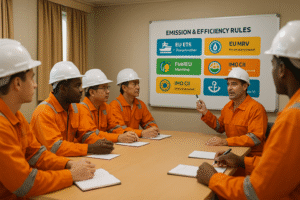

This learning material is prepared to help seafarers with sailing experience onboard ships clearly understand the latest international and regional regulations. It explains each rule with objectives, details, and practical examples so that by reading only, you can connect the regulations with daily shipboard work
Objective:
The objective of the European Union Emissions Trading System (EU ETS) is to make ships accountable for the carbon dioxide (CO₂) they emit while trading in the European Union. By creating a financial cost for emissions, the EU motivates shipowners to save fuel and reduce pollution.
Key Details:
Example:
Just like paying tolls in Suez or Panama Canal, the EU ETS becomes another cost line in voyage accounts, listed as ‘ETS Carbon Cost’.
Onboard Impact:
The ship’s reported fuel consumption directly impacts company costs, so accurate reporting is vital.
Objective:
The objective of European Union Monitoring, Reporting, and Verification (EU MRV) is to measure and verify the ship’s CO₂ emissions fairly and accurately for voyages linked with the EU.
Key Details:
Example:
If the noon report indicates 25 tons, but the logbook records 23 tons, and the bunker note shows 24 tons, the MRV will be questioned, and the company may be required to pay more.
Onboard Impact:
All records, including logbooks, noon reports, and bunker delivery notes, must be consistent.
Objective:
The objective of FuelEU is to ensure that ships calling at EU ports use fuels that are cleaner and less carbon-intensive and to reduce emissions while alongside by utilizing shore power.
Key Details:
Example:
A ship burning LNG produces less carbon per ton of energy compared to one burning heavy fuel oil, so the LNG ship is favored under FuelEU.
Onboard Impact:
The crew may need to handle new fuels, such as LNG or methanol, and must prepare for shore power connection operations.
Objective:
The objective of the IMO Carbon Intensity Indicator (CII) is to grade ships based on efficiency in terms of grams of CO₂ emitted per ton of cargo per nautical mile.
Key Details:
Example:
A vessel sailing slower and with a clean hull will use less fuel per ton-mile and achieve a better grade than a faster vessel with a fouled hull.
Onboard Impact:
Crew actions like adjusting speed, using weather routing, and keeping the hull clean directly improve the ship’s grade.
Objective:
The objective of the IMO Energy Efficiency Existing Ship Index (EEXI) is to ensure older ships meet a minimum energy efficiency standard, similar to how older cars must pass pollution checks.
Key Details:
Example:
A ship’s engine may be limited so that it cannot always run at maximum power, except in emergencies.
Onboard Impact:
Masters and chief engineers must consider these limits during voyage planning.
Objective:
The objective of the IMO Data Collection System (DCS) is to gather annual fuel consumption data from ships to help the IMO monitor and control global shipping emissions.
Key Details:
Example:
If DCS shows 10,000 tons fuel use in a year but MRV shows 9,500 tons, auditors will investigate the mismatch.
Onboard Impact:
Accuracy and consistency in reporting are critical for compliance.
Objective:
The objective of Annex VI is to protect the environment and human health by reducing sulphur oxides (SOx) and nitrogen oxides (NOx) emissions from ships.
Key Details:
Example:
Before entering the North Sea ECA, a ship must switch to a fuel with a sulphur content of 0.10%. Failing to do so can result in heavy fines.
Onboard Impact:
The crew must carefully perform fuel changeovers and keep bunker notes, fuel samples, and changeover logs ready for inspection.